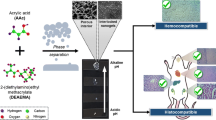Abstract
We synthesized, thermo- and pH-sensitive gels and tested them as skin extenders. Our aim is the development of copolymer and composite hydrogels that, when implanted under the human skin, swell osmotically and thereby induce skin growth. In the course of the polymerization reaction, we produced copolymers with variable compositions, starting from different acrylic compounds [N-isopropyl-acrylamide (NIPAAm), acrylamide (AAm), and acrylic acid (AAc)]. The mechanical strength and the swelling stability of the gels are enhanced by the addition of fillers [Na-montmorillonite and Na-montmorillonites organophilized with alkylammonium ions (Cn-m.), n = 4, 12, 18]. With this method we synthesized composite hydrogels. We observed that in the case of composites synthesized with the addition of fillers, relatively low filler contents (1–5 wt.%) resulted in more extensive swelling and stronger gel structure. During the experiments, the monomer composition (0/100–100/0 mol% NIPAAm/AAm or AAc) and the cross-link density (50–1500 mol%) of the gels (M/C ratio) and, in the case of composites, the quality and quantity of fillers are varied. The filler content of composites varies between 1 and 25 wt.%. The extent of swelling and the viscoelastic properties can be manipulated through the ratios of these parameters. In the case of certain copolymer and composite gels, values of desorption enthalpy (ΔH m) corresponding to the actual water contents were also determined by thermoanalytical measurements (differential scanning calorimetry, DSC). Swelling values determined by gravimetry and enthalpies calculated from DSC measurements were found to be in good correlation. Even in the case of the relatively hydrophobic poly(NIPAAm)-based gels, an enthalpy value of 98.41 kJ/mol was obtained, which is twice the value measured in pure water (41.74 kJ/mol). Evaluation and comparison of the rheological and DSC results also allowed conclusions to be drawn concerning the types of interaction operating among the three components of the system, i.e., the polymer skeleton and the filler and water molecules.








Similar content being viewed by others
References
Hoffman AS (2002) Advan Drug Delivery Rev 43:3
Khetani SR, Bhatia SN (2006) Biotechnology 17:1
Keshava Murthy PS, Murali Mohan Y, Sreeramulu J, Mohana Raju K (2006) React Funct Polym 63:11
Benoit DSV, Nuttelman CR, Collins SD, Anseth KS (2006) Biomaterials 27:6102
Hervas Perez JP, Lopez-Cabarcos E, Lopez-Ruiz B (2006) Biomol Eng 23:233
Bussow K, Konthur Z, Lueking A, Lehrach H, Walter G (2001) Am J Pharmacogenomics 1:37
Kioussis DR, Kofinas P (2005) Polymer 46:9342
Liu P, Peng J, Li J, Wu J (2005) Rad Phys and Chem 72:635
Nerapusri V, Keddie JL, Vincent B, Bushnak IA (2006) Langmuir 22:5036
Das M, Kumacheva E (2006) Colloid Polym Sci 284:1073
Crowther HM, Vincent B (1998) Colloid Polym Sci 276:46
Shibayama M, Suda J, Karino T, Okabe S, Takehisa T, Haraguchi K (2004) Macromolecules 37:9606
Shibayama M, Karino T, Miyazaki S, Okabe S, Takehisa T, Haraguchi K (2005) Macromolecules 38:10772
Haraguchi K, Li HJ, Matsuda K, Takehisa T, Elliott E (2005) Macromolecules 38:3482
Haraguchi K, Li HJ (2006) Macromolecules 39:1898
Miyazaki S, Karino T, Endo H, Haraguchi K, Shibayama M (2006) Macromolecules 39:8112
Miyazaki S, Endo H, Karino T, Haraguchi K, Shibayama M (2007) Macromolecules 40:4287
Haraguchi K, Li HJ, Okumura N (2007) Macromolecules 40:2299
Jiang H, Su W, Mather PT, Bunning TJ (1999) Polymer 40:4593
Jones DS, Lorimer CJ, Andrews GP, McCoy CP, Gorman SP (2007) Chem Eng Sci 62:990
Cauich-Rodriguez JV, Deb S, Smith R (1996) Biomaterials 17:2259
Masci G, Bontempo D, Crescenzi V (2002) Polymer 43:5587
Fernández E, López D, López-Cabarcos E, Mijangos C (2005) Polymer 46:2211
Nandi S, Henning Winter H, Fritz HG (2004) Polymer 45:4819
Ricci EJ, Bentley MVLB, Farah M, Bretas RES, Marchettia JM (2002) Eur J Pharm Sci 17:161
Bonacucina G, Cespi M, Misici-Falzi M, Palmieri GF (2006) Int J Pharm 307:129
Gelfer M, Horst RH, Henning Winter H, Heintz AM, Hsu SL (2003) Polymer 44:2363
Yu Y, Xu Y, Ning H, Zhang S (2008) Colloid Polym Sci 286:1165
Bako J, Szepesi M, Veres AJ, Cserhati Cs, Borbely ZsM, Hegedus CS, Borbely J (2008) Colloid Polym Sci 286:357
Anseth KS, Bowman CN, Brannon-Peppas L (1996) Biomaterials 17:1647
Alexandre M, Dubois P (2000) Mater Sci Eng 28:1
Sinha Ray S, Bousmina M (2005) Prog Mater Sci 50:962
Ma J, Xu Y, Zhang O, Zha L, Liang B (2007) Colloid Polym Sci 285:479
Xia X, Yih J, D’Souza NA, Hu Z (2003) Polymer 44:3389
Churochkina NA, Starodoubtsev SG, Khokhlov AR (1998) Polym Gels Netw 6:205
Strachotová B, Strachota A, Uchman M, Šlouf M, Brus J, Pleštil J (2007) Polymer 48:1471
Yeh JM, Liou SJ, Chang YW (2004) J Appl Polym Sci 91:3489
Xiang Y, Peng Z, Chen D (2006) Eur Polym J 42:2125
Meyvis TKL, Stubbe BG, Van Steenbergen MJ (2002) Int J Pharm 244:163
Metzger TG (2002) The rheology handbook. Vincentz Verlag, Hannover
Zaman MA, Martin GP, Rees GD, Royall PG (2004) Thermochim Acta 417:251
Zhang XZ, Chu CC (2005) Polymer 46:9664
Mohan YM, Murthy PSK, Sreedhar B, Raju KM (2006) J Appl Polym Sci 102:1
Agrawal AM, Manek RV, Kolling WM, Neau ST (2003) Pharm Sci Tech 4:1
Szilágyi A, Zrínyi M (2005) Polymer 46:10011
Acknowledgments
This work was supported by the Hungarian National Office of Research and Technology (NKTH) and the Agency for Research Fund Management and Research Exploitation (KPI) under contract no. RET-07/2005 and the Cooperation Research Centre (DEAK) of the University of Szeged (28/00/0R201).
Author information
Authors and Affiliations
Corresponding author
Rights and permissions
About this article
Cite this article
Janovák, L., Varga, J., Kemény, L. et al. Investigation of the structure and swelling of poly(N-isopropyl-acrylamide-acrylamide) and poly(N-isopropyl-acrylamide-acrylic acid) based copolymer and composite hydrogels. Colloid Polym Sci 286, 1575–1585 (2008). https://doi.org/10.1007/s00396-008-1933-8
Received:
Revised:
Accepted:
Published:
Issue Date:
DOI: https://doi.org/10.1007/s00396-008-1933-8




